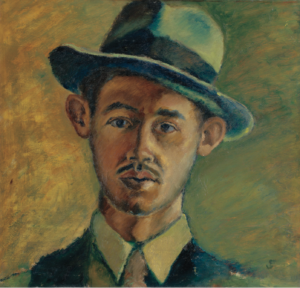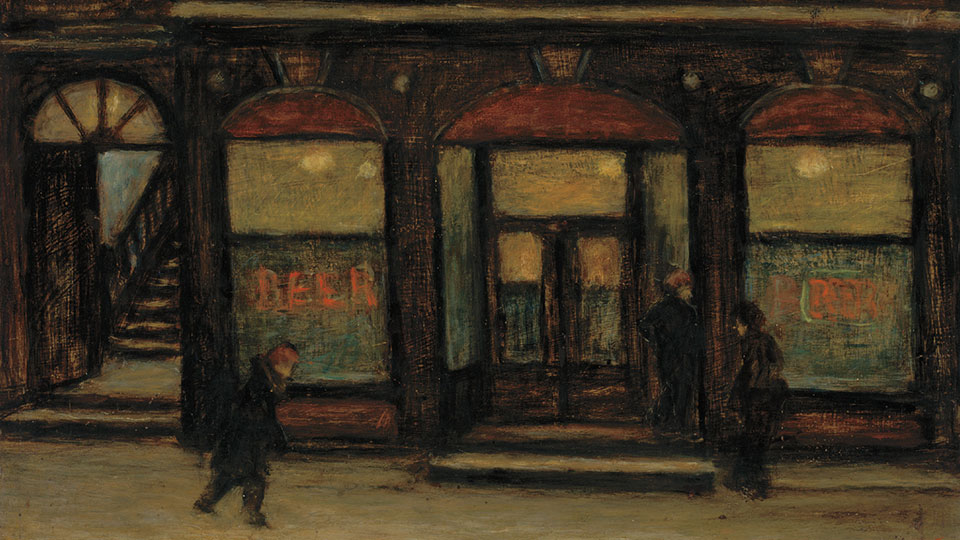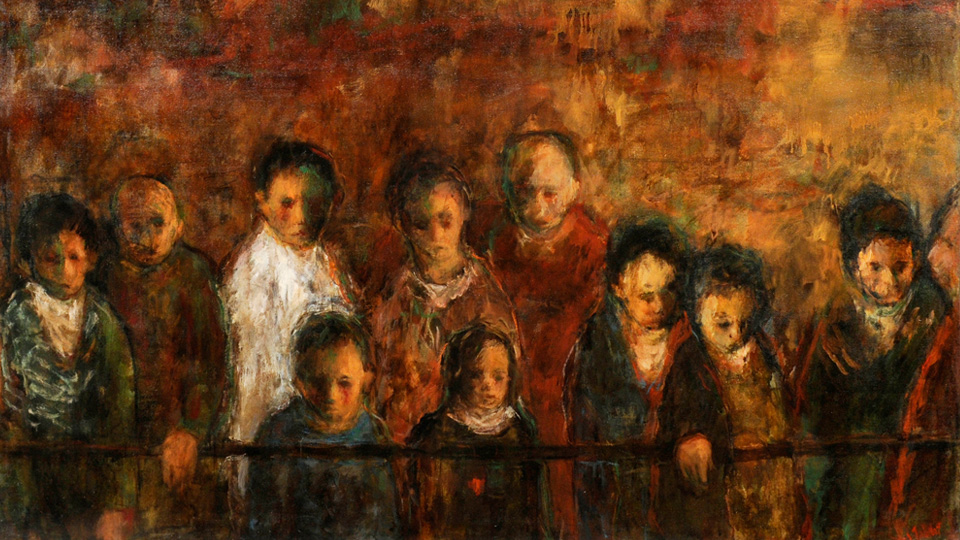 MUSEUM OF WISCONSIN ART PRESENTS
MUSEUM OF WISCONSIN ART PRESENTS
JOSEPH FRIEBERT: A LIFE IN ART
A retrospective celebrating the artist’s seventy-year career and a recent donation of sixty-seven artworks to the museum.
WEST BEND, Wis. (August 1, 2018): The Museum of Wisconsin Art (MOWA) is pleased to announce the retrospective exhibition, Joseph Friebert: A Life in Art, which will feature more than fifty works in the Hyde Gallery. Opening with a party on Saturday, August 18, A Life in Art, celebrates the life and career of one of Wisconsin’s most distinguished artists and a major donation of artworks to the museum, establishing MOWA as the largest repository of Friebert’s oeuvre.
“Friebert’s work is strikingly original and not as well know as it deserves.” said MOWA Executive Director | CEO Laurie Winters. “His painting is steeped in some of the darkest moments of Wisconsin and American history—from the Great depression to World War II to the racism and social inequity of the 1960s and 1970s. His thoughtful meditations on the human spirit provide a valuable counterpoint to the buoyant movements of the mid-twentieth century that dominate so much of our thinking about American art.”
Called one of Wisconsin’s greatest “living treasures” by the late James Auer, Milwaukee Journal art critic, Joseph Friebert (1908–2002) enjoyed a long and distinguished career, becoming one of the state’s leading artists and a beloved and influential teacher.
“Friebert’s work can be found in over forty museums across the country. MOWA is now the museum of record with more than 100 paintings and works on paper.” said MOWA Director of Exhibitions and Collections Graeme Reid. “Joseph Friebert has left us a great legacy. That legacy is now accessible to current and future audiences as part of the remarkable and resonant story of outstanding art and artists with Wisconsin connections.”
Friebert’s art reflects an overriding concern for the human condition. The figures in his often dimly lit Social Realist compositions of the late 1930s and 1940s—whether behind bars, in line-ups, picking coal, or walking city streets—seem stoic and melancholy. To enhance the pensive mood of his work, Friebert developed a form of “indirect painting,” adopting Old Master techniques involving the layering of pigments and glazes. This brooding quality is also found in his land- and cityscapes of the period.
In the late 1940s and 1950s, Friebert switched to a semi-abstract style, breaking urban forms—buildings, skyscrapers, churches and synagogues, walls—into blocks of glowing, dusky colors. Concurrently, he produced symbolic figural compositions to express his dismay at the political and social ills of the Cold War period.
From the mid-1960s until the end of his life, Friebert worked exclusively in a lush figurative manner, employing masterful, loose brushwork and a brighter palette. He continued to engage with his preferred themes: refugees and the persecuted, city scenes and landscapes, families and groups in interiors and exteriors. He never stopped drawing, a subject he taught throughout his years at the University of Wisconsin–Milwaukee.
During his lifetime, Friebert showed extensively throughout the Midwest, including in numerous juried group exhibitions at which he frequently won prizes, and in one-person displays at museums and galleries. His art hung in shows at major museums across the United States and in 1956 was featured in the American pavilion at the Venice Biennale.
In 2015–16, the Kohler Foundation and Friebert’s family presented the Museum of Wisconsin Art with sixty-seven works—paintings, watercolors, drawings, and prints—from all periods of his life. Joining numerous works already in the collection, the donation establishes MOWA as the largest repository of Friebert’s oeuvre. Celebrating the artist and the gift, Joseph Friebert: A Life in Art will include almost fifty examples from our collection, as well as important loans.
EXHIBITION ACTIVITIES
JOSEPH FRIEBERT: A LIFE IN ART
On View: August 18–October 7, 2018
Museum of Wisconsin Art | Hyde Gallery
Free with Membership | Walk-ins Welcome
LATE SUMMER EXHIBITIONS OPENING PARTY
Saturday, August 18 | 2:00–5:00
Celebrate the opening of four exhibitions and enjoy art making, live music, light bites, and a cash bar.
Free with Membership | Walk-ins Welcome
JOSEPH FRIEBERT: PAINTER AND PARENT
Saturday, August 25 | 2:00–3:00
Joseph Friebert’s life and career will be the focus of a talk by his daughter, Susan Friebert Rossen. Formerly the publisher at the Art Institute of Chicago and the Detroit Institute of Arts, Rossen will combine personal insights with her art-historical and museum background to provide a full view of her father and his art.
Free with Membership | Walk-ins Welcome
CASUAL CONVERSATIONS WITH THE AUTHOR
Saturday, September 8 | Anytime from 2:00–4:00
Meet Susan Friebert Rossen in the Hyde Gallery where she will share stories about her father, Joseph Friebert. Purchase your copy of the Joseph Friebert: A Life in Artfull-color catalogue in the MOWA Shop and get it signed by the author.
Free with Membership | Walk-ins Welcome
TALK WITH ROBERT COZZOLINO
Saturday, September 15 | 2:00–3:00
Join Robert Cozzolino—Patrick and Aimee Butler Curator of Paintings at the Minneapolis Institute of Art—as he explores Joseph Friebert’s work, how it connects to American modernism, and its deviation from the Wisconsin art of his time.
Free with Membership | Walk-ins Welcome
EXHIBITION SUPPORT
Support for 2018 exhibitions is generously provided by James and Karen Hyde, Cynthia and Tom LaConte, Greater Milwaukee Foundation, Pick Heaters, Wisconsin Arts Board, and Julie and John Dedrick.
ABOUT MOWA
The Museum of Wisconsin Art (MOWA) explores the art and culture of Wisconsin. Founded in 1961, MOWA is one of the top museums of regional art in the United States, with over 5,000 works of contemporary and historic art by more than 350 artists. Through rotating exhibitions and educational programs, MOWA provides an innovative forum for the culturally engaged.
In 2013, MOWA opened its new 32,000-square-foot facility in downtown West Bend. The building, the first museum commission by acclaimed architect Jim Shields of HGA Architects, is situated along the west bend of the Milwaukee River on a triangular plot of land that inspired the facility’s modern wedge shape. An expansive wall of windows follows the curve of the river bank and minimizes the boundaries between interior and exterior. The museum houses five permanent collection galleries, three temporary exhibition spaces, and two classrooms as well as visible art storage, a shop, and a large atrium for public events.
Credit: Joseph Friebert, Self-Portrait, Oil on Masonite, 1936, Gift of Joseph and Betsy Ritz Friebert Family Partnership




